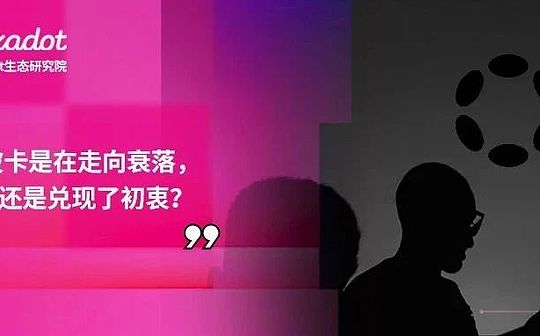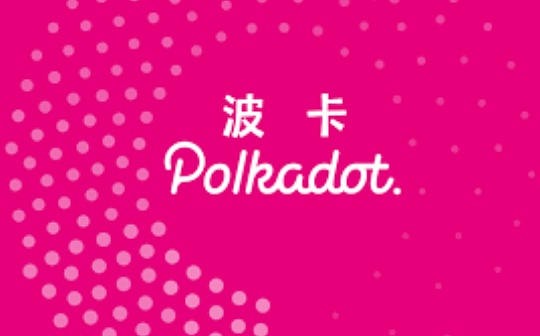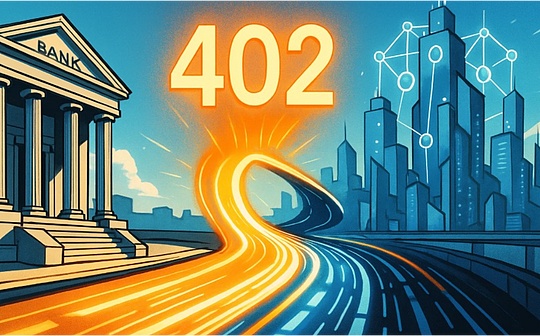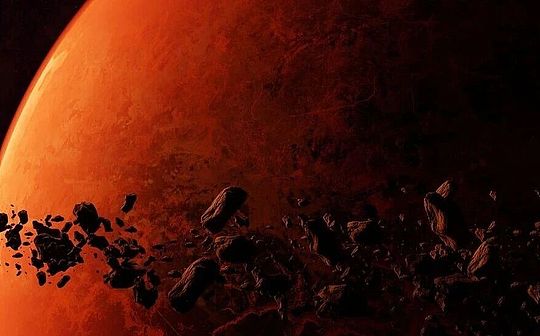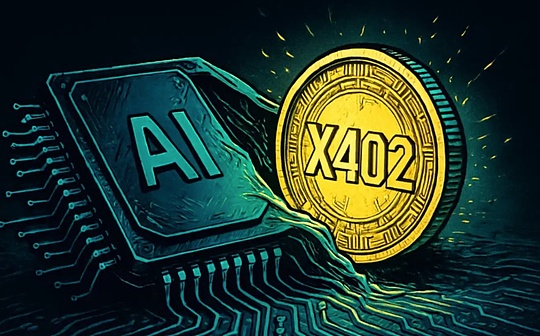
Author: Coin Bureau Editorial Team, compile: OneBlock+
-
White paper and initial concept (2016):Polkadot White Paper was released in 2016 by Gavin Wood, outlined many innovative multi -chain frameworks.
-
WEB3 Foundation Start (2017):Web3 Foundation is established to promote decentralized networks with complete functions and friendly users.It played a key role in funding and guiding the development of Polkadot.
-
ICO and fundraising (2017):Polkadot’s first token issuance (ICO) in 2017 was one of the most successful issuances at the time, raised more than $ 140 million.However, a large part of the funds were frozen due to Parity wallet vulnerabilities.
-
Development Milestone (2018-2019):Polkadot has undergone testing and development at various stages, and launched an experimental Canary Network -Kusama network.
-
Main network startup (2020):Polkadot’s main network was launched in 2020, and the network function in the first stage was limited.Subsequently, Polkadot launched complete functions, including enabled governance, pledge and binding functions.
-
Parallel chain launch and auction (2021-2022):The introduction of parallel chain is a key feature of Polkadot. Starting from the auction of these slots, it marks an important step in implementing the Polkadot multi -chain architecture.
-
Web3 Foundation announced that DOT tokens are no longer securities (2022):After years of discussion with the SEC, Polkadot announced that DOT was software, not securities.
-
Polkadot 2.0 (2023):The new technology update marks the end of the parallel chain slot auction. This is one of the most important events in the encryption field, which will make the more vibrant parallel chain market be adopted.
-
Cardano announced the use of Polkadot Technology (2023):At the Cardano Summit in 2023, Hoskinson announced that Cardano will use Polkadot SDK for its partner chain.
Other founders:
In addition to Gavin Wood is the core figure of Polkadot development and co -founder of Ethereum, the founding team of Polkadot also includes several other well -known people:
-
Robert Habermeier:Important contributors of Rust and blockchain communities have been actively participating in the development and conceptualization of Polkadot technology.
-
Peter Czaban:The technical director of the Web3 Foundation played an important role in guiding the mission of the Foundation and supervising the development of Polkadot’s technology.
-
Role:NPOS involves two main roles:
-
Verification:Responsible for verifying transactions and maintaining blockchain.
-
Nominee:Celebrate tokens by supporting trusted authenticants to help protect the Internet.
-
Nomination verification person:Tokens holders can nominate the verifications of trust.This process involves the native currency DOT pledged Polkadot.
-
Election of verifications:The election mechanism selects the verification from the nominated library.This process considers the betting of each verification person to ensure the balance and security of a network.
-
Praising rewards and risks:Both verifications and nominations will receive a pledge reward proportional to their pledge amount.However, they also have a common risk: any malicious behavior of the verificationer may cause reduction (SLASH), thereby losing part of the dripping DOT.
-
Safety and efficiency:NPOS aims to maximize the amount of pledge of the network and increase its security.Due to the economic interests involved, the verificationrs are motivated to execute in an efficient and honest way.
-
Protocol design:XCM is the language and format of the message.It is designed as as universal and abstract as possible to adapt to extensive potential use cases and blockchain design.
-
Message sending and receiving:The parallel chain can send XCM messages to another parallel chain without storing these messages on the relay chain.
-
Cross -consensus compatibility:XCM aims to be compatible with different consensus systems.This means that the blockchain using a consensus mechanism can use different mechanisms to communicate with another blockchain.
-
Use case:XCM has a variety of uses, which can include transmission to tokens between parallel chains, calling smart contracts located on another parallel chain, or any other types of information or commands that may need to communicate in a multi -chain environment.
-
Power decentralization and security:XCM uses the Polkadot sharing security model to ensure that cross -chain communication is as safe as the internal operation of a single parallel chain.
-
Message creation:Users or applications on parallel chain initiate cross -chain operations to create XCM messages.This message is formatted and is generally understood between different parallel chains with different consensus mechanisms and status conversion functions.
-
Submit to the local parallel chain:The XCM message is first submitted to the local parallel chain.Here, it will be processed according to the rules of the parallel chain and is preparing to transmit it to another parallel chain.
-
Participation of relay chain:The local parallel chain forwarded the XCM message to the POLKADOT relay chain; the relay chain played a core role in the Polkadot architecture, connecting all parallel chains to each other and promoting communication between them.
-
Message route:The relay chain puts the message route to the target parallel chain. This route is based on the information contained in the XCM message. The message specifies the target flat chain and expected operation.
-
Destination Parallel link receiving:The target parallel link receives the XCM message from the relay chain, explains the message according to the logical and performs the request operation.
-
Execution and response:The operation of the target flat -line execution of the XCM message may involve token transfer, smart contract execution or other blockchain operations.
-
Feedback cycle:According to the nature of cross -chain operation, the target flat chain can generate response or confirm and use the same XCM protocol to send it back to the original parallel chain.
-
Finally determined:After the operation is completed, any change is finally determined on the source and target flat chain.
-
Auction format:Polkadot uses a version of Candle Auction, which is a mechanism used in history.The end of the auction is determined by traceability after the auction, so it is difficult to deceive the system by bidding in the last minute.
-
Bidding:By locking the DOT token to bidding, the number of DOT locking and the lease period is a factor in the bid process.
-
Random end:Participants do not know the exact end time of the auction, which prevents the last minute bidding strategy.
-
The winner is determined:The winners are the project with the highest bidding at randomly selected auction.
-
Lease slot:The winning project can rent a parallel chain slot during the bidding period; during this period, their parallel chain will be connected to the relay chain.
-
Lock dot:The DOT tokens bid in the auction are locked during the slot lease. They are not spent, but as a margin to ensure the position of the parallel chain on the relay chain.
-
In order to collect enough DOT for bidding,Projects usually use public loansThey raised DOT from the community.
-
If the bidding is successful, the contributor to the crowd mayWill get rewards from the projectFor example, token or project share.
-
Disopoly of the council and technical committee:The council has disbanded collectively, and the broader Polkadot technical team replaced the technical committee.
-
Direct democratic voting system:The responsibilities of the council have been transferred to the public, and the public can significantly initiate new proposals.
-
Enhanced representative authorization options:Users can entrust the voting rights to community members in a diverse way, so as to represent the interests of stakeholders more detailed.
-
Multi -origin (Origins) and Tracks:The proposal is now initiated by the public and enters different running tracks according to its nature. Each track has a dedicated origin.The system allows voting for multiple referendums at the same time, thereby improving the flexibility and response ability of the governance process.
-
Decentralization:OpenGOV shifted the governance power from the Central Council to a more direct democratic model.By dissolving the council and the technical committee, and transferring their responsibilities to the public, OpenGOV promoted the formation of decentralized decision -making methods.
-
Tolerant and community empowerment:OpenGOV introduces more detailed authorization options to encourage more extensive participation in governance. Related stakeholders can contribute to decision -making in the fields they know or most interested in.
-
Adaptability and evolution:Introduce multiple origin and proposal tracks in OpenGOV, and establish a more flexible and faster governance system that can adapt to different types of proposals to ensure that the governance process is efficient and effective.
-
Transparency and accountability system:The ability to introduce and quickly handle proposals in the technical team enhances the rapid response capabilities of rapid response or improvement of the rapid response or improvement of the network.
-
Scalability and efficiency:OpenGov’s design allows voting multiple referendum at the same time, thereby improving the efficiency of governance systems.This scalability is essential for dynamic core time management systems in Polkadot 2.0.
-
Resource allocation rigidity:The original slot auction model is assigned a parallel chain slot for a fixed period, and the lack of flexibility to meet the changes in different projects or changes in network conditions.
-
The high entry threshold for new projects: high:Need a lot of locking.
These founders have brought unique technical highlights and visions to the project, and contributed to the development of Polkadot into a scalable, interoperable and secure multi -chain ecosystem.Their efforts are the key to promoting Polkadot to achieve sustainable development in the blockchain field.
DOT token ICO and financing round
The first token sale of Polkadot’s DOT practical tokens is still staying in the memory of many senior people in the encrypted assets, as is it for the Polkadot team.DOT ICO was held in October 2017 and raised more than in Ethereum$ 145 millionEssence
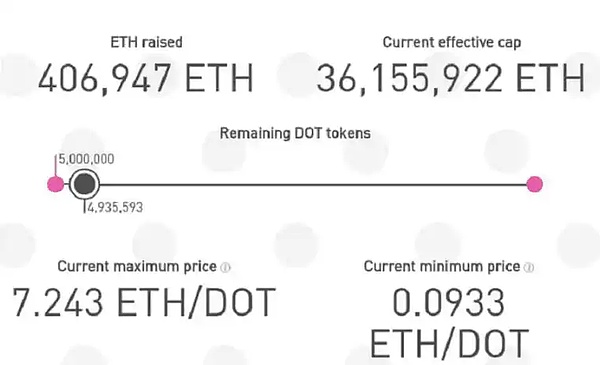
Snapshot from POLKADOT ICO, pictures from TrustNodes
DOT initial supply is10 million, Half of which are divided into two rounds28.8 dollarsThe initial price was sold to public and private investors (2.25 million and 2.75 million, respectively).
However, in August 2020, DOT renovated after voting in the community, which actually caused each DOT holder to increase by 100 DOT.The re -determined price causes the actual ICO price of the DOT token to$ 0.29Essence
Shortly after the ICO price adjustment, because Polkadot’s vulnerabilities in the wallet code were used and raisedMore than $ 9,000 millionFund is permanently frozen.One week after the incident, the Polkadot team confirmed that although the funds were frozen, there was still enough funds to develop Polkadot.Although I have worked hard to recover funds, there are stillMore than 500,000 ETH is locked.
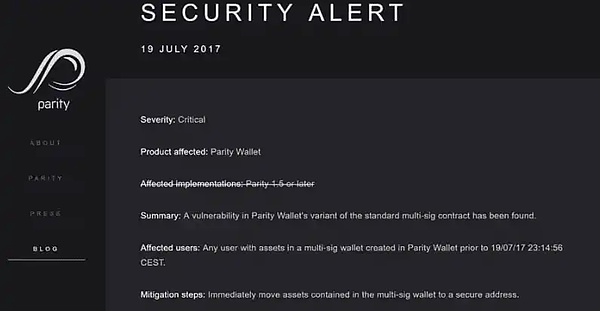
The first Polkadot wallet was attacked by hackers, the picture came from Steemit
Collector
The collector helps the verification person to reach a consensus by constructing a parallel chain block, and the collector maintains a full node of the specific parallel chain and the full node of the relay chain.As a complete node in parallel chain, they retain all the necessary information, such as transaction data, signatures and status conversion to build a parallel chain block.They organize and execute parallel chain transactions to create parallel chain blocks; provide these blocks to one or more verifieders who propose parallel chain blocks, as well as zero -knowledge proof of parallel chain transactions.
& lt; span ROOTID “:” Hz0cdxa2mo9ao5xopizuj50ESWH “,” Text “: {” Initialattributedtexts “: {” Text “: {” 0 “:” The collector can assist the verification person to reach consensus and collectors to assist the verifications and collectors. Maintenance specific parallelThe full node of the chain and the whole node of the relay chain.As a complete node in parallel chain, they retain all the necessary information, such as transaction data, signatures and status conversion to build a parallel chain block.They organize and execute parallel chain transactions to create parallel chain blocks; provide these blocks to one or more verifieders who propose parallel chain blocks, as well as zero -knowledge proof of parallel chain transactions.”},” Attribs “: {” 0 “:”*0+3*1+4*0+4*1+6*0+1*1+5*0+n*1+2*0+4*1+I*0+2*1+E*0+4*1+9*0+5*1+3*0+4*1+3*0+8*1+5*0+3*1+4*0+1*1+4*0+3*1+c “}},” Apool “: {” numtoattrib “: {” 0 “: [” Author “,” 72566036598325253 “],” 1 “: [1”: [1 “: [1”: [1 “: [1”: [1 “: [1”: [1 “:”Author”, “708818769251446789”]}, “NextNum”: 2}}, “Type”: “Text”, “ReferenceRecordMap”: {}, “Extra”: {“Mention_page_tital”: {}, “EXTER nal_mention_url “: {{}}.154}.
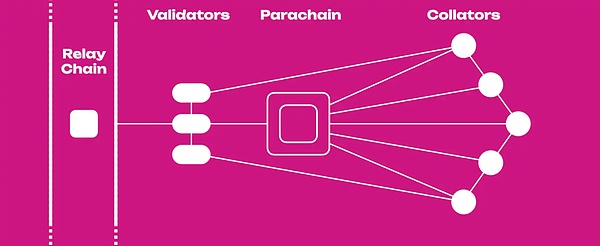
The collector is located in the POLKADOT network, the picture comes from Polkadot Wiki
Polkadot consensus
The Polkadot relay chain uses a novel nomination equity proof (NPOS) consensus process to protect the block, which aims to optimize network security and efficiency.The following is its working principle:
In short, Polkadot’s NPOS is a complex consensus model that adjusts the incentive measures of various network participants to maintain a safe, efficient and decentralized ecosystem.
Polkadot XCM(Cross -chain message transmission)
The Polkadot relay chain uses a novel nomination equity proof (NPOS) consensus process to protect the block, which aims to optimize network security and efficiency.The following is its working principle:
In the POLKADOT ecosystem,XCM represents cross -consensus message transmissionEssenceThis is an agreement designed for communication between the Polkadot and the Kusama network and the external blockchain (parallel chain).XCM enables these different blockchains to send messages, although it may have different consensus mechanisms or status conversion functions.The following is the detailed situation of how XCM promotes cross -chain communication:
In short, the XCM in Polkadot is a powerful tool for achieving interoperability between different blockchain in a safe, efficient and decentralized manner.This is the cornerstone established by PolkadotEssenceXCMP is a transmission layer that transmits XCM messages. It provides transportation methods and security routes, but does not provide a framework for constraints.
The process of XCM cross -chain message
In Polkadot, XCM promotes cross -chain messages involving multiple steps.
The following is a detailed information:
Throughout the process, Polkadot’s security and consensus mechanism ensure the security and reliability of cross -chain communication.The XCM protocol is designed as a general and abstract message transmission format, allowing various cross -chain interactions in the Polkadot ecosystem.
How to choose from parallel chain?
The Ethereum network does not need to be licensed at all, which means that as long as the consensus process of the Ethereum agreement is observed, anyone can perform any operations on the network.therefore,Developers deploy any smart contract they want online in Ethereum main online(Including smart contracts Rollups) have complete autonomy.
The working principle of the POLKADOT network is slightly different. The initial vision of this project is to connect the high -quality and efficient parallel chain to the relay chain and benefit from its security.Therefore, Polkadot introduced the slot auction mechanism to monitor the number of parallel chains on Polkadot at any time.The following is the auction method before the Polkadot 2.0 upgrade.
1. Purpose:
The slot auction is used to determine which parallel chain will be connected to the Polkadot relay chain, and the connection to the relay chain allows the parallel chain to benefit from the shared security and interoperability of Polkadot.
2. Parallel chain slot:
These are the available positions that can be connected to the parallel chain on the relay chain.The duration of each slot is limited, usually ranging from several months to several years.
3. Auction process:
4. Win auction:
5. Lock dot:
The DOT tokens bid in the auction are locked during the slot lease. They are not spent, but as a margin to ensure the position of the parallel chain on the relay chain.
6. Crowloan:
7. End of the lease:
After the lease period is over, the parallel chain slot will be auctioned again, and the locked DOT will be returned to the project or its loan contributors.
Slot auction is the basic part of Polkadot’s governance and economic model, ensuring that it is fair and transparent in the process of allocating limited resources (parallel chain slots) in the network.
Core time in Polkadot(Coretime)
Polkadot network validators are dynamically allocated to verify different parallel chain blocks.Polkadot is randomly divided into each parallel chain subset through a set of verificationrs, so as to provide strong guarantees, so that these subsets are different in each block.
CoreTime refers to the availability of these verified assets as computing resources (core) allocation, and Polkadot is currently supported50Such a core.Each core can host a parallel chain that uses all resources, or multiple parallel threads that use some available resources to operate in parallel operation, and handle multiple complex tasks at the same time.Polkadot is also called“Polkadot Super Computer”It represents the collective ability to deal with a large number of tasks.
Polkadot OpenGov-D democratic governance structure
Polkadot has recently reformed the governance mechanism.It abandoned Governance V1 and adopted OpenGOV, which is a more democratic and fair agreement governance format, reduced privileges and gave the DOT community a greater right to speak.We recommend reading the content of the Governance V1 (https://wiki.polkadot.network/docs/learn- Governance) to understand the changes introduced by OpenGOV.
Farewell to Governance V1
The first governance system of Polkadot includes three main components: technical committees, councils, and public (all token holders).The technical committee is responsible for managing and upgrading the timetable, and the council is a election agency, responsible for handling parameters, management and expenditure proposals.Although the public (token holder) is played during the governance processCritical role, But the council will carefully review their proposals before they enter the voting stage.
Although Governance V1 has significant effects in managing the government treasury funds and promoting upgrades, there are some limitations.It only allows voting (except for emergency proposals) for one referendum at a time, and the voting period lasts for several weeks.The system tends to carefully consider a small amount of proposals, rather than a wider idea, which may limit the ability of the network to adapt and develop rapidly.V1 also restricts the public’s speech by implementing the council and must be recognized.The demand for greater decentralization and democracy has led to the adoption of OpenGOV.
Polkadot OpenGov
Polkadot OpenGov has changed major changes to the shortcomings of Governance V1.The new system aims to further decentralize decision -making and increase the possible number of collective decisions at any given time.Main changes include:
Notice:For those who want to know more information, you can also understand the working principle of OpenGov: https://www.youtube.com/watch? V = Iv7b4zxuzomom
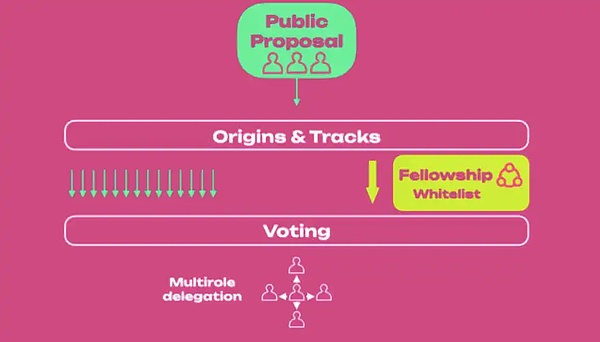
OpenGOV architecture described in Polkadot Docs
In OpenGOV, DOT holders initiated all proposals, unlike Governance V1, OpenGOV allows the community to handle multiple proposals parallel.OpenGOV divides the proposal into a goal based on its goal15 categories of different originEssenceEach origin follows a special “track”, including the preset configuration to manage the voting process.Origin and rail systems ensure that each proposal can fully contact the time and resources of the community.
Some governance proposals have time sensitivity and require decisive decisions, while others are more basic and dense, and more thinking and testing.OpenGOV is a platform. On this platform, all these different proposals will not grab the attention of the community and can achieve comprehensive development.
The main benefits of OpenGOV:
Polkadot 2.0 proposed a new network direction, abandoned its regular slow auction model, and adopted a dynamic “payment” model to insert the parallel chain into the Polkadot network.But at the same time,The new vision points out some restrictions on the existence of slot auctions, as shown below:

